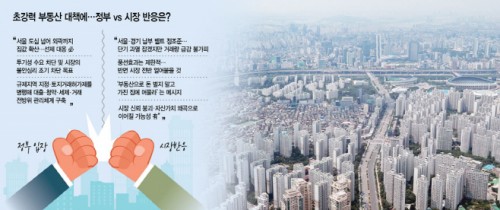 |
The government unveiled an “ultra-strong” real estate package that simultaneously designates all of Seoul and 12 areas in Gyeonggi Province as regulated zones and land-transaction permit districts. While the measures are expected to cool short-term overheating, concerns are mounting that the greater Seoul housing market could effectively slip into a “trading halt.”
Compounding the fears, tighter finance rules are raising lending hurdles even for end-users, and the risk of supply disruptions across the capital region is seen as significant—making medium- to long-term side effects hard to avoid, analysts say.
On October 15, the government announced its “Measures to Stabilize the Housing Market,” placing every Seoul district and 12 Gyeonggi areas under the designations of “areas subject to adjustment,” “overheated speculative districts,” and “land-transaction permit zones.” It is the first time the entire capital region has been locked into a single regulatory regime.
Government touts ‘gap-investment clampdown’ and short-term cooling
Citing an unabated price climb despite two earlier rounds—June 27 lending curbs and September 7 supply steps—and signs of gains spreading from central Seoul to outlying areas, authorities reached for the toughest card. By expanding designations to include land-permit zones as well, the aim is to brake demand across loans, subscriptions, taxes, and “gap” investing, and to deflate any “balloon effect” in prices.
“The current market combines supply-demand imbalance risks with rate-cut expectations. Without timely action, comprehensive market management would be difficult,” a Land Ministry official said.
The adjustment and overheated-zone designations take effect on the day after notice in the official gazette—October 16—while the land-permit zones run from October 20 through December 31, 2026. The ministry will review the adjustment and overheated designations every six months via the Housing Policy Deliberation Committee and reassess the land-permit zones when the term ends.
With 27 places in the capital region now facing tougher rules on mortgages, subscriptions, and taxation, “gap” buys using jeonse leases are expected to be effectively blocked—pointing to an inevitable slump in transactions.
Financial curbs, in particular, are being ratcheted up. The loan-to-value (LTV) cap for first-time and “to-be-sold” single-home buyers drops to 40% from 70%, while multi-home owners are barred from new mortgages altogether. Jeonse loans will also be counted under the debt-service ratio (DSR), further tightening access to credit.
Market frets over transaction cliff and supply squeeze; ‘trust damage’ risk
Experts concede the package could tame near-term froth but warn of unavoidable aftershocks such as a deal drought and supply uncertainty. Notably, the uniform 600 million won cap on mortgage principals will now be tiered by home price, cutting limits to 400 million won for the 1.5–2.5 billion won bracket and to 200 million won above 2.5 billion—raising fears that funding for genuine high-end buyers will be effectively choked off, deepening the freeze.
The direct market shock could be sizable. According to data firm Real Estate R114, a total of 2.3 million homes—1.568 million in Seoul and 742,000 across the 12 Gyeonggi areas—fall within the newly designated zones and will be directly affected. Some 592,000 high-priced homes above 1.5 billion won (25.6%) will see loan limits cut, sharply increasing funding burdens.
“October 15’s package centers on tiered loan caps and land-permit designations that put the brakes on apartment ‘gap’ investing,” said Park Won-gap, senior expert at KB Kookmin Bank. “It squarely targets the southern Gyeonggi belt—Gwacheon, Seongnam, Yongin, Suwon—as well as all of Seoul to stop price spillovers.”
“This follows June 27 as a second shock therapy. Buyers will step to the sidelines, and a market-wide pause is likely,” he added. “Some listings may emerge and prices dip briefly, but with all key areas in Seoul and the capital region under the permit regime, any balloon effect should be limited.”
Lee Eun-hyung, research fellow at the Korea Research Institute for Construction Policy, said the crux is the immediate application of zone designations and loan curbs. “As regulation widens, volumes will plunge and price swings narrow, but controversy over prices set on thin trading will be inevitable,” he said, adding that any balloon effect would likely be confined to a handful of adjacent areas.
While the package may serve as a strong short-term brake, some warn against an overreliance on regulations. Doubts are growing over the feasibility of the government’s September 7 pledge to supply 1.35 million homes in the capital region. Without credible supply backing, they say, today’s curbs may quell a spike only for instability to return later.
“A regulation-centric approach can weigh on the market,” Lee said. “Finding balance between demand activation and controls is key. In past cases, even a deliberately ambiguous policy stance sometimes aided stability.”
Nam Hyuk-woo of Woori Bank’s Real Estate Research Institute said the combined designations across Seoul and major Gyeonggi areas would slash deal volumes. “Among redevelopment sites, only those where members can transfer their association rights will trade, so listings are likely to shrink,” he noted.
“This is more than a price-control move—it’s a policy signal to redirect asset allocation,” said Yang Ji-young, a senior adviser with Shinhan Premier Pathfinder. “It aims to push property out of the retail investment toolkit and pull liquidity toward financial markets—basically, ‘don’t flip houses; stay put in the one you own.’”
Yang also warned of a potential “price blackout,” where asking prices persist but transactional reference points vanish. “While it may cap short-term spikes, it risks long-term damage to market trust and distortions in asset values,” she said. “Severed deal flows can entrench inequality: highly mobile upper-tier wealth captures gains, while middle- and lower-income buyers face a blocked entry, widening the asset gap.”
Most Read
-
1
-
2
-
3
-
4
-
5
-
6
-
7





















